I was really surprised when I saw the turtle pictured above. First, this species of turtle, a Red-eared Slider, is not known to occur in the wild in Franklin County. Second, what on earth is wrong with its shell? ![]() Let’s look at it more closely.
Let’s look at it more closely.
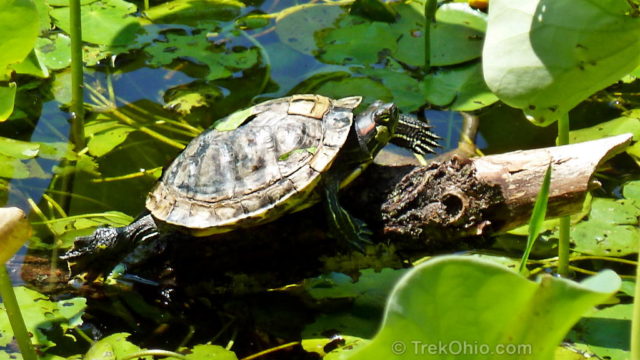
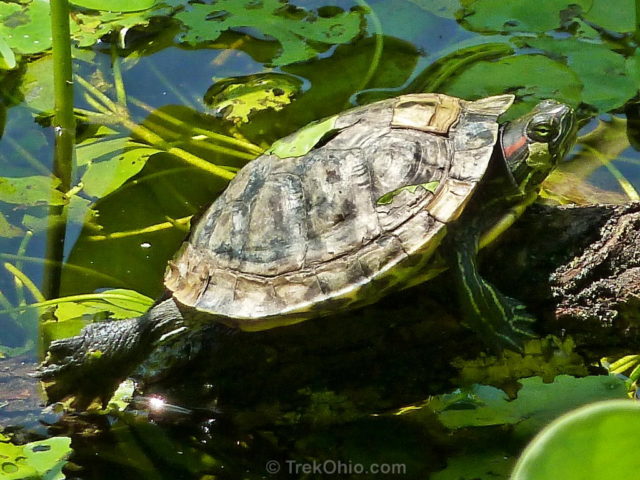
The turtle’s shell is subdivided into sections called scutes. In my photo there is a front scute that’s a lighter color, almost a light brown, toward the front of the shell. It seems to be raised above the surrounding scutes. Toward the rear edge of the shell you can see the surface of one scute peeling away from the shell.
I found myself wondering if this turtle was sick, so when I got home I started searching the Internet to see if it was normal for a turtle to have a peeling shell. Most of my search results directed me to forums or blogs that focused on exotic pets, pet turtles, or more specifically, pet Red-eared Slider Turtles. Which brings me back to why I was surprised to see this species of turtle in the wild in Franklin County.

While researching my post on Ohio’s 12 species of turtles at a glance I came across a map of the turtle’s distribution in Ohio (excerpted from Reptiles of Ohio Field Guide). As you can see the Red-eared slider is not widely distributed in Ohio. Although native to the southeastern United States, for years this species of turtle has been a popular terrarium pet. It’s believed that the Red-eared sliders found in Ohio are probably released pets or the descendants of released pets. So the little guy with the peeling shell seen above may have once been in someone’s terrarium. 🙁 I feel that I should mention that in Ohio it is illegal to release these pets into the wild. Doing so can endanger the local turtle species. For instance released Red-eared Sliders in California have been out-competing the local western pond turtles.
It turns out that it is normal for the outer layer of scutes to peel away as the turtle grows. I knew that snakes shed their skins when they go through a growth spurt, but it turns out that this same process holds true for all reptiles. Turtles shed both their skin and the outer surface of their shells to make way for a larger version of themselves.
The scutes are made of keratin, the same stuff that forms fingernails and hooves. I repeatedly found websites claiming that healthy shedding involved thin, nearly transparent layers of keratin peeling off of the scutes. In my photo I didn’t think that the peeling layer looked transparent. After inspecting a number of photos and videos of these peeling scutes, I think it is somewhat misleading to use the word “transparent.” The peeled scutes seem to have portions that contain pigment, while other portions may be translucent much like fingernails.
The author of the blog, Pet Turtles and More, has published photos of the thin, shedded layers of his pet’s scutes here. You can clearly see that the layers are not transparent, but they are also completely intact contradicting everyone else who says that the keratin comes off in bits. He has observed his turtle eating the intact, shedded keratin, so he believes that those who claim that the keratin comes off in bits are actually seeing the excreted remnants of digested keratin. ![]() To see a different pet owner peeling the loose keratin from his turtle, check out this YouTube video. Apparently he’s not the only pet owner to do this. The motivation for helping the peeling process along is to keep the sloughed off bits from clogging up the water filter for the aquarium. The people arguing against it seem to worry that the shell underneath might not be quite ready to be exposed yet. An alternative way of keeping the aquarium filter clear is to frequently use a special, underwater vacuum when your pet turtle is shedding to keep the aquarium extra clean during this process.
To see a different pet owner peeling the loose keratin from his turtle, check out this YouTube video. Apparently he’s not the only pet owner to do this. The motivation for helping the peeling process along is to keep the sloughed off bits from clogging up the water filter for the aquarium. The people arguing against it seem to worry that the shell underneath might not be quite ready to be exposed yet. An alternative way of keeping the aquarium filter clear is to frequently use a special, underwater vacuum when your pet turtle is shedding to keep the aquarium extra clean during this process.
While the surface keratin is peeling off their shells, aquatic turtles like to do lots of basking in the sun like the wild turtle pictured above. Basking both heats and dries the peeling keratin and helps it to come off.
And I’ll close with a weird, turtle fact. I ran into an educational video about Red-eared Sliders. The video explained that one way to distinguish between male and female Red-eared sliders is that the males have considerably longer claws on their front feet. Much as a male bird might display its awesome plumage to a prospective mate, the male Red-eared Slider dangles his awesome claws in front of a female turtle to coax her into becoming receptive to his advances. Having fabulous claws is a sign of health for the Red-eared Slider, and long claws suggests that the offspring will also be healthy and robust.
Additional information
- Ohio’s 12 species of turtles at a glance, published by TrekOhio.com
- Turtle Shell, published by Wikipedia
- Red-eared slider, published by Wikipedia
- Shell Conditions, published by RedEarSlider.com
- Do Turtle Shells Peel?, published by Exotic Pets at About.com
More on Reptiles and Amphibians
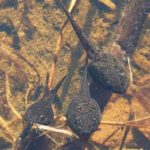
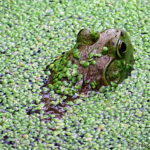
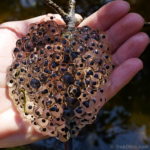
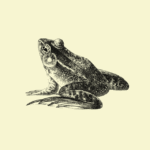
I had a pet red ear slider before, purchased at a pet store, so I’m positive of my identification.
I was born and raised in Holmes county Ohio. We absolutely have red ear sliders here. Take a bike ride on the trail behind Walmart south 2 to 3 miles. You’re likely to see 30 to 50 basking in the sun. They are also in the swamp along 62 going between Millersburg, and Killbuck. I have a cousin that used to catch baby ones there.
Reblogged this on MothersHeart.
Fascinating! I learned something…! I hope this guy survives in your area. People need to think, think, THINK.